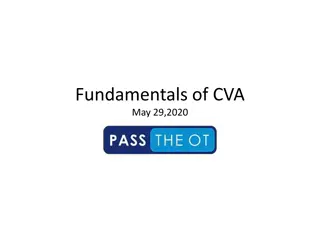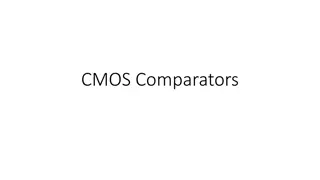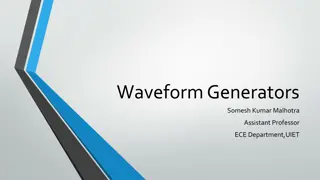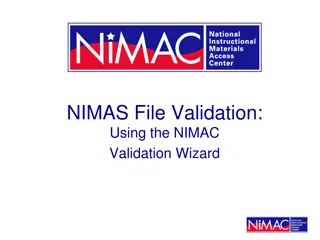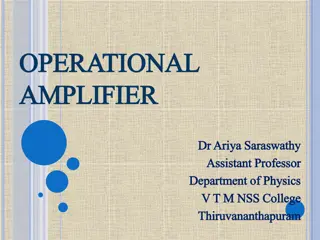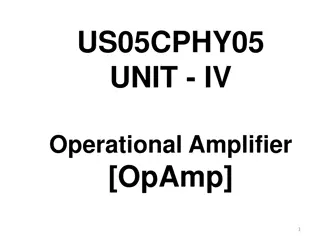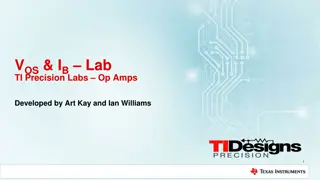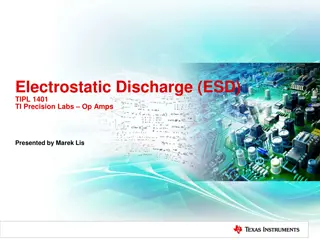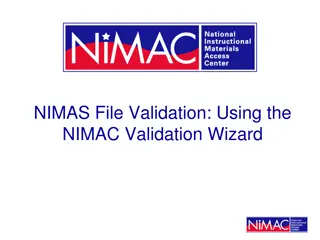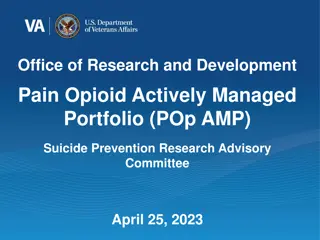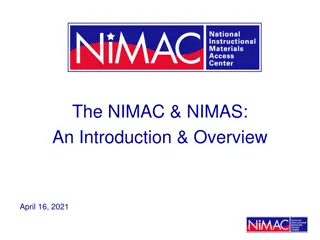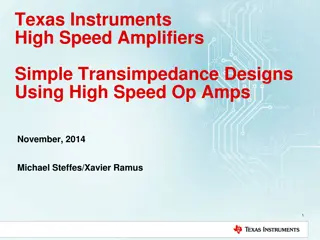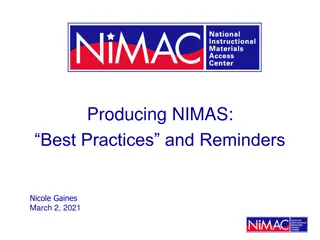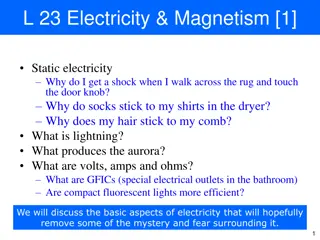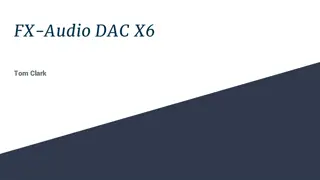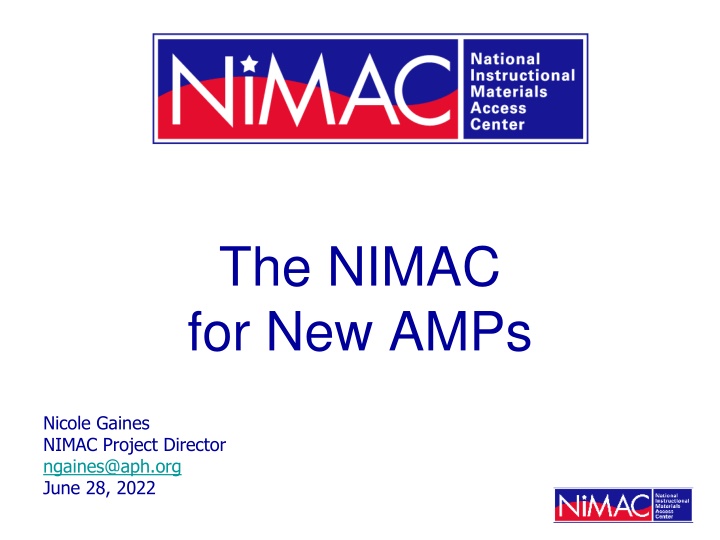
Introduction to NIMAC for Accessible Educational Materials
Explore the National Instructional Materials Accessibility Center (NIMAC) and its role in providing accessible formats for K-12 instructional materials. Learn about NIMAS, file production, submission process, and more. Discover how NIMAC supports students with diverse needs in accessing educational content effectively.
Download Presentation

Please find below an Image/Link to download the presentation.
The content on the website is provided AS IS for your information and personal use only. It may not be sold, licensed, or shared on other websites without obtaining consent from the author. If you encounter any issues during the download, it is possible that the publisher has removed the file from their server.
You are allowed to download the files provided on this website for personal or commercial use, subject to the condition that they are used lawfully. All files are the property of their respective owners.
The content on the website is provided AS IS for your information and personal use only. It may not be sold, licensed, or shared on other websites without obtaining consent from the author.
E N D
Presentation Transcript
The NIMAC for New AMPs Nicole Gaines NIMAC Project Director ngaines@aph.org June 28, 2022
Todays Webinar Part 1: Introduction to the NIMAC NIMAC Background Authorized Users & AMPs File Assignment Process Services & System Features for AMPs Part 2: System Demo! Downloading Files Managing File Assignments Using the Watchlist
The NIMAC Project Created by IDEA 2004, the NIMAC is the national source file repository for K-12 textbooks and instructional materials. We make NIMAS files available for use in producing accessible formats for K-12 instructional materials. We have over 69,000 file sets from 166 educational publishers. All 50 states (plus the 6 eligible territories) work with the NIMAC.
What is NIMAS? NIMAS is the National Instructional Materials Accessibility Standard. An XML-based source file format established for the sole purpose of use in producing accessible formats such as braille, DAISY, EPUB, or large print. NIMAS files require further conversion work into an accessible format before use. NIMAS is not distributed directly to students.
NIMAS Production NIMAS is not a by-product of print or digital book production, so NIMAS is not a format that publishers have on hand. NIMAS must be separately created after print books are finalized. Publishers do not produce their own NIMAS files they outsource this work to digital content conversion vendors. It can take up to six weeks or more for NIMAS to be produced.
How we get files Under IDEA 2004, the only mechanism to require NIMAS from the publisher is the book adoption contract or purchase agreement. There is no blanket requirement under IDEA for publishers to submit files to the NIMAC. States and districts have been able to require NIMAS when they purchase new textbooks since 2006. The goal is that when NIMAS is included in contracts, a file will already be available in the NIMAC when a need is identified.
Types of materials we receive NIMAC receives a wide range of student- facing instructional materials. These include textbooks, workbooks, supplementary readers, and ancillary materials such as blackline masters. Exempt materials include teacher s editions, pre-2006 titles, trade books, college textbooks, reference books. We can also now accept NIMAS files for some digital instructional materials.
Student Eligibility Materials produced from NIMAS can only be distributed to qualifying students in elementary or secondary education. Students must have both: 1. An Individualized Education Program (IEP); and 2. A certified disability under the NLS Eligibility Guidelines. NIMAS is not available for use on behalf of students outside of the U.S. or the eligible territories.
College Students NIMAS is not available for use on behalf of students in higher education. However, the AccessText Network is a program that helps provide accessible files to students in higher education. AccessText works through DSS offices at colleges and universities.
How the NIMAC works with states Each state that agrees to work with the NIMAC names a State Coordinator. This individual is responsible for designating Authorized Users (AUs) for the state. Since NIMAS is not distributed directly to schools or students, the number of Authorized Users for each state is small. AUs are from within the educational structure of the state. They are involved in or manage accessible format production for K-12 students in that state.
What can an Authorized User do? An Authorized User account provides full access to the NIMAC repository. An AU can search and download files directly to their computer. They can also assign files for download to registered Accessible Media Producers (AMPs). Authorized Users must be designated by a State Coordinator and their access is limited to work on behalf of the specific state.
What can AMPs do? AMPs cannot directly search and download any file from the repository. An AMP account allows the user to download any file assigned to them by an Authorized User. AMP accounts are freely available to nonprofit and for-profit providers. These users do not have to be designated by a State Coordinator, and they can do work on behalf of any state.
Should I be an AMP? If you answer Yes to the questions below, an AMP account may be a good option for you! Do you do work on behalf of one or more states or districts to produce braille or other accessible formats for students in K-12 education? Do you use NIMAS (or are you learning how to use NIMAS) in your production processes? Do you produce a relatively small number of titles and need only periodic access to download files?
Should I be an AU? If you need access to download many files from the system, it may be appropriate for you to be designated as an Authorized User for a given state. To become an AU, you must be designated by the State Coordinator. You also need to be a part of the educational structure of the state or a nonprofit that qualifies as an authorized entity under Chafee. Contact us if you have questions or would like more information.
Registering as an AMP To begin an AMP registration, email nimac@aph.org with your name, email address and organization name. We will enter the registration in the system, and you ll receive an automated email with a link to complete the registration. Be sure to complete all the registration information, including your format capabilities. If you produce a format not on the pick list of options, just choose Other to indicate this.
Limitation of Use Agreement (LUA) The email with the registration link will also include the Limitation of Use Agreement as an attachment. Just initial each page, complete section 14.0, and return the document to us either in hard copy or digital format. Validated digital signatures (e.g., DocuSign) can be accepted. Once we have both the online registration and LUA, we can activate your account.
Side Note: the APH AMP Directory AMP information in the NIMAC is not public. AUs can only access information about AMPs through their NIMAC accounts. If you are interested in sharing information publicly about the services you offer, we invite you to participate in the Accessible Media Producers Directory. This searchable online directory is a free service of APH (separate from the NIMAC). Contact resource@aph.org for more information!
AMP Accounts: NIMAS File Assignment
Working with AUs Once you have an active AMP account, any Authorized User in any state can assign you files for download. The NIMAC itself is not involved in any business arrangements between states/districts and AMPs. If you are working on a project for a state or district and need help locating an AU in that state to assign you the NIMAS file, just let us know.
File Assignment File assignment happens when an Authorized User logs into their account, locates a file in the NIMAC, and assigns it to your account for download. AUs pick you out from an alphabetical list by Organization Name. Be sure that the AU knows how you listed your organization in the NIMAC so they can find you in the list.
Requested Format When the AU assigns the file, they will also choose a format from the format capabilities that you listed when you registered with the NIMAC. The format information is supplied in the file assignment as a convenience and does not restrict you to producing that accessible format. The format capabilities that you can list in your account information include the many commonly produced formats but are not exhaustive.
Email Notification When you are assigned a file by an Authorized User, the system will send an automated email to let you know that the file is available for download in your account. The notification will include information about: the file that has been assigned the accessible format requested the user who made the assignment Please be sure to alert us if your email address changes and needs to be updated in the system.
Spam Filter Heads Up All automated emails from the NIMAC will show as the sender noreply-NIMAC@overdrive.com. We recommend that you add this email address to your contacts list so that your email server will recognize it as a valid sender and (hopefully) not filter the emails as junk or spam. If you encounter any issues receiving emails after taking this step, please contact your IT department for help and/or reach out to us for additional assistance.
Final Note on Emails All the information provided in the automated emails is also available to you in the system. Not receiving the notification (or deleting an email) will not prevent you from being able to download the file. However, successfully receiving the emails will keep you from having to log in to check to see if a file you re waiting on has been assigned to you yet.
System Features and Services for AMPs
The Watchlist Research & Expedite Service If a file you need is not available in the NIMAC, you can add the ISBN to your Watchlist. NIMAC will research the item for you and try to obtain/expedite NIMAS for the title. If the title is outside of scope for NIMAS, we ll try to research other alternatives for you. You will also receive an automated email once the file is available in the NIMAC.
MathML and NIMAS MathML is optional XML markup for math and scientific notation. The benefit of MathML is that, when software supports it, it can be used to automatically generate braille or other formats. In the past, math was most often provided in NIMAS as images, which cannot automatically be converted into braille.
No MathML Download Many publishers now provide MathML in their NIMAS files--however, not all software supports MathML. If a NIMAS file includes MathML, but your software does not support MathML, you can choose to download the file without MathML. We will show you this download option during the demo.
Does the file include MathML? The NIMAC system will only show a No MathML download option if MathML is present in the file. This is one easy way to know whether a file contains MathML. You can also verify whether a file includes MathML by looking at the system record or the XML file.
Producing Formats Using NIMAS AMPs generally rely on proprietary software to produce accessible formats. Providing training on how to use third-party software or set up production workflows is not generally under the purview of the NIMAC. However, we were pleased to recently offer two training courses for braille transcribers. The 2022 trainings will be archived and remain available free of charge on the APH Hive and the NIMAC website.
Keeping the Conversation Going We are also considering setting up two transcriber User Groups (for Duxbury and Braille 2000 users, respectively) for ongoing support. Preliminary ideas are that the groups would be: relatively informal; facilitated by a skilled transcriber; meet bi-monthly or quarterly; and provide an opportunity for transcribers to connect and share information and pointers on textbook transcription.
If you are interested . . . Please let us know by emailing us at nimac@aph.org if you like the idea of the user groups and would like to see us pursue this. We are also interested in any ideas you have for how to set up the groups to best benefit transcribers.
Any Questions? For any questions about how to use NIMAC or the status of files in the NIMAC system please contact us for assistance: nimac@aph.org 877-526-4622 The content of this resource was developed under a grant from the US Department of Education, #H327E210001. However, these contents do not necessarily represent the policy of the US Department of Education, and the reader should not assume endorsement by the Federal Government. Project Officer: Rebecca Sheffield.


